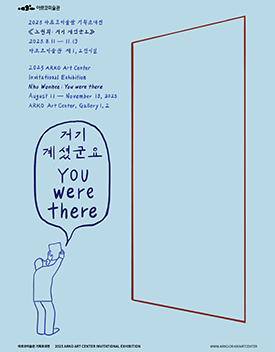전시
-
2023 아르코미술관 기획초대전 《노원희: 거기 계셨군요》
- 전시기간
- 2023.08.11~2023.11.19
- 관람료
- 무료
- 오프닝
- 장소
- 아르코미술관 제 1,2전시실
- 작가
- 노원희
- 부대행사
- 작품 해설 쓰기 워크숍, 읽기모임, 토크 프로그램
- 주관
- 아르코미술관
- 주최
- 한국문화예술위원회
- 문의
- 02-760-4850
2023년 아르코미술관 기획초대전 《노원희: 거기 계셨군요》
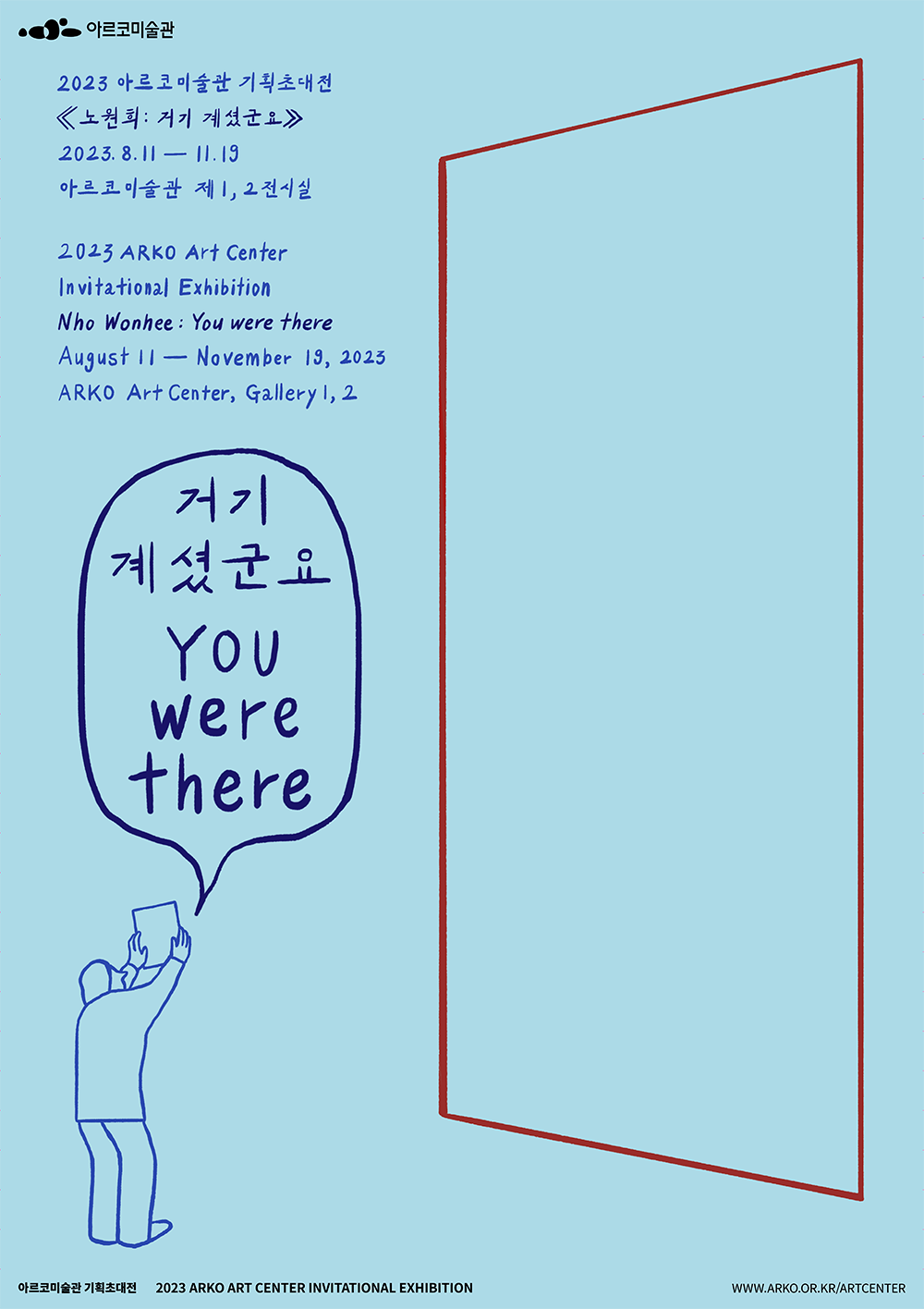
▣ 전시개요
- 제목 : 2023 아르코미술관 기획초대전 《노원희: 거기 계셨군요》
- 작가 : 노원희
- 기간 : 2023년 8월 11일(금)-11월 19일(일)
- 운영시간 : 화-토요일, 11시-19시(매주 월요일 및 추석 당일 휴관)
- 장소 : 아르코미술관 제 1,2전시실
- 관람료 : 무료
- 주관 : 한국문화예술위원회
▣ 전시소개
아르코미술관 기획초대전은 중진·원로 작가의 신작 및 창작활동을 지원하고, 그간 펼쳐온 작가의 작업 세계를 집중 조명하는 전시로 2023년도에는 노원희(b. 1948)의 개인전을 개최한다. 노원희는 1977년 개인전을 계기로 본격적인 미술 활동을 시작했고, 1980년 소집단 미술운동 ‘현실과 발언’의 창립 구성원으로 참여했다.
《현실과 발언》 창립전은 1980년 문화예술진흥원 미술회관(현 아르코미술관)에서 개최될 예정이었으나 정치적 메시지가 강하게 드러난다고 여겨졌던 당시의 사회 분위기로 인해 무산되었다. 개관 50주년을 앞둔 아르코미술관은 작가 노원희를 기획초대전에 초청하여 이러한 역사를 오늘의 관점에서 되짚어 보고, 오랜 시간 작업 활동을 해오며 개인과 사회를 바라본 작가의 관점을 세심히 따라가 보고자 한다.
《노원희: 거기 계셨군요》는 노원희의 1980년대 회화부터 신작 회화, 대형 천 그림, 참여형 공동작업, 신문 연재소설 삽화, 아카이브 등 작가의 작품세계를 조망할 수 있는 130여점의 작품과 자료를 선보인다. 노원희는 민중미술, 부산형상미술, 비판적 현실주의라는 열쇠 말로 언급된다. 그러나 노원희의 그림과 예술 실천의 궤적을 자세히 살펴보면 기존 미술사에 기술된 다양한 사조와 언어에 포착되지 않는 지점을 발견하게 된다. 말 없는 그림으로 발언하기, 인간과 세상에 대한 공감과 연민의 마음, 현실과 역사를 대하는 그의 태도를 따라가다 보면 그가 붓질로 감각하고 감지했던 시대의 심리적 형상을 만날 수 있게 된다. 따라서 이번 전시는 미술가이자 생활인으로서 목격하고 체험했던 개인적, 사회적 차원의 인간사를 회화라는 시각언어를 통해 기록하려는 작가의 예술적 지향점을 살펴볼 수 있는 기회가 될 것이다.
노원희의 그림은 개인과 집단이 경험한 사회의 정황과 심리를 증언한다. 그는 1980년대부터 정치적 억압과 민주화 투쟁 양상이 첨예해지는 시대적 분위기를 긴급하게 담아냈다. 사회 변혁 운동의 전선이 사라진 후 정치사회적 혼란과 자본주의 사회의 구조화된 폭력의 그림자는 일견 담담해 보이는 일상에 드리웠고, 불평등, 모순, 소외의 형태가 사적 차원에서 더욱 정교하게 체감되는 시대로 이행하였다. 이러한 상황에서 노원희는 현실을 직시하면서 사회의 구조적 모순과 인간 조건에 대한 성찰을 지향하였다. 그의 예술적 실천은 현실을 정확하게 인지하고 이를 회화의 언어로 전달하며 소통하는 것이기 때문이다. 이는 비판적 현실주의자로서 노원희가 상투적 현실에서 떼어낸 현실의 진실된 모양새를 탐구하는 방식이자 역사 인식하에 현실을 담담하게 기록하려는 그의 의지와도 관련이 있다. 그의 그림은 우리가 발 딛고 있는 현실에서 미시정치로 인해 발생하는 교묘한 억압과 폭력의 구조가 모호하게 감지되기만 할 때, 현실을 직면하는 밝은 눈이 되어주고 현실 너머의 현실을 모색하는 창이 되어준다.
전시는 사회 문제를 향한 발언과 의지의 표현이 공적 영역과 사적 영역에서 교차하는 지점을 보여주는 방식으로 구성된다. 제1전시실에서는 1980년대부터 노동자와 권력의 형상을 다뤘던 연장선상에서 한국 자본주의의 구조적 문제로부터 비롯된 산업재해와 피해자 개인들의 고통에 공감하는 신작을 선보인다. 산업재해의 피해자들은 우리 시대에 생존과 인간의 존엄성을 위협 받는 청년, 노동자, 투쟁하는 사람들의 서사로 연결된다. 제2전시실에서는 작가가 여성으로서 겪은 여성 서사에 대한 관심과 일상, 사적 공간에 침투하는 폭력과 억압 그리고 인류 보편 서사에 대한 작가의 성찰을 보여준다. 개인의 삶과 가정, 부엌과 같은 사적 공간에 드리운 사회적 억압과 배제는 사적 공간이 사회적 공간이고 정치 투쟁의 장소일 수밖에 없음을 깨닫게 한다.
작가에게 궁극의 지향점은 단순한 재현을 넘어 개인과 사회의 근원적 정황을 형상화하는 것에 있다. 따라서 이번 전시는 공적 영역과 사적 영역에서 감춰진 노동과 몸의 형상화를 통해 사회적 타자와 존재들이 펼쳐내는 연대의 이미지를 발견하기를 기대한다. 전시의 제목 “거기 계셨군요”1)는 사회 바깥에 남겨진 누군가에게 건네는 말이다. 이 부름의 말은 그 사람의 자리를 확인하고 이후의 대화를 이어가기 위한 일종의 호명이다. 대화를 이어가고자 하는 호명은 이후 전개될 이야기를 떠오르게 한다. 고통의 삶에 마음을 보태고 그 자리에 있는 누군가의 이름을 불러주고 확인하는 것에서부터 사회의 변화는 시작되며, 이는 노원희가 지향하는 ‘그림과 말’의 힘일 것이다.
1) “거기 계셨군요”는 작가 노트에서 가져왔다. 작가는 영화 「라스트 왈츠」(1978)에서 밴드의 마지막 공연이 끝나고 커튼을 치자 관객이 앉아 있는 것을 바라보면서 했던 대사 “거기 계셨군요”를 인용한다. 이어 현실과 발언이 한 시대의 역사로, 기록으로 남았고 그 선언의 의미가 변했다는 것에 빗대어 “거기 안 계시는군요”로 바꿔 적는다. 전시의 제목 “거기 계셨군요”는 노원희의 그림에서 호명하는 개인의 자리, 그리고 인간의 삶이 이어지는 시간을 떠올리는 것으로, 나아가 우리가 꿈꾸는 다음 사회의 도래를 은유한다.
▣ 주요 섹션 소개
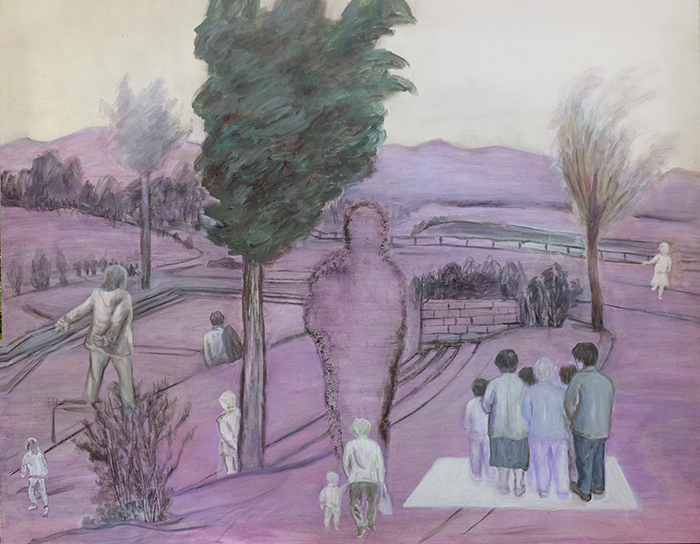
노원희, <공원을 떠나는 시간>, 2016, 캔버스에 아크릴릭, 유채, 91×117cm
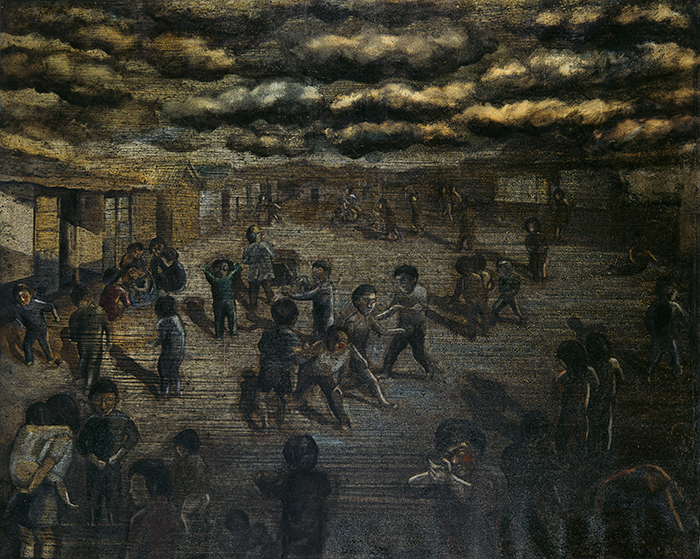
노원희, <한길>, 1980, 캔버스에 유채, 130.3×162.1cm. 국립현대미술관 소장
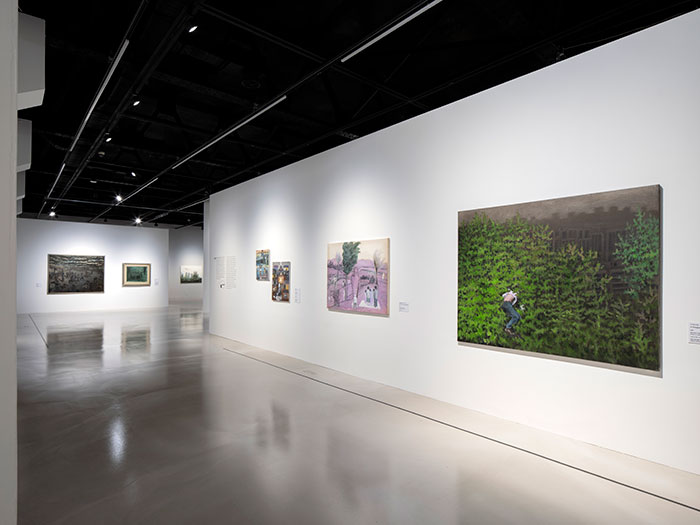
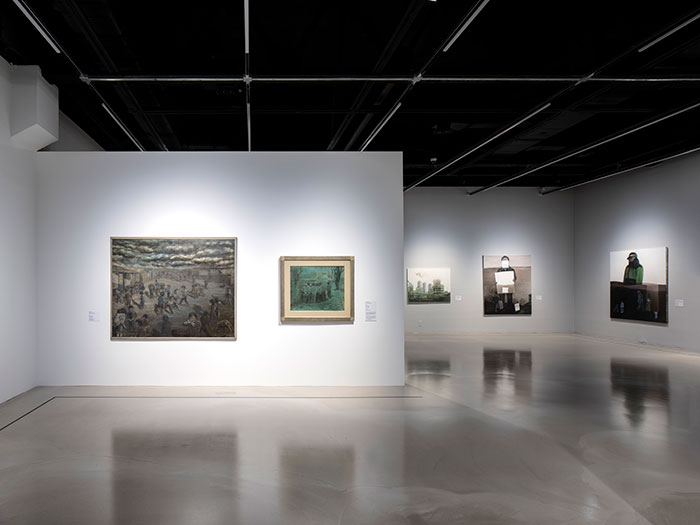
작품 설치 전경
1980년대 한국의 사회운동은 변혁적인 민족민중운동으로 나아가며 삶에 대한 총체적 인식을 탐구했다. 그리고 치열한 저항운동의 결실로 오랜 군부독재 하에 빼앗긴 정치적 자유가 회복되기 시작했다. 그러나 1980년대 민중문화운동을 추동한 거대서사에 대한 관심이 사라지는데 걸리는 시간은 그리 길지 않았다. 1990년대에 이르러 문화계 전반에 걸쳐 투쟁의 전선이 사라지고 서구의 포스트모더니즘이 유입되면서 1980년대 문화운동의 비판적, 도덕적 비전의 무게를 벗어던진 감각적인 신세대 문화가 등장한 것이다. 급변한 시대의 그늘 속에서 민중미술가들 또한 정신적 혼돈을 극복하기 위해 방랑과 고뇌를 거듭하였고, 나아가 변화하는 사회문화적 상황을 성찰하고 새로운 길을 모색하는데 힘을 기울였다.
당시 노원희는 시대의 새로운 비전이나 매체미술 같은 표현 방식과 어법에 끌리기보다 삶의 저변에 여전히 건재한 현실 사회의 모순에 주의를 기울이고 있었다. 이러한 변환의 시대를 살아가는 목격자이자 화가로서 그는 시대의 변화가 일으킨 정황을 감지하고 이를 캔버스 위에 반영했다. 그의 회화는 한 시대가 저물고 그 잔재들이 다시 재구성되어 새로운 모습으로 등장하는 단절, 전환, 연속의 국면을 드러낸다. 그림에 드리운 무거운 공기와 부재의 그림자는 시대의 뒷모습이자 현실의 모습을 만들고 리얼리티의 외상을 드러낸다.
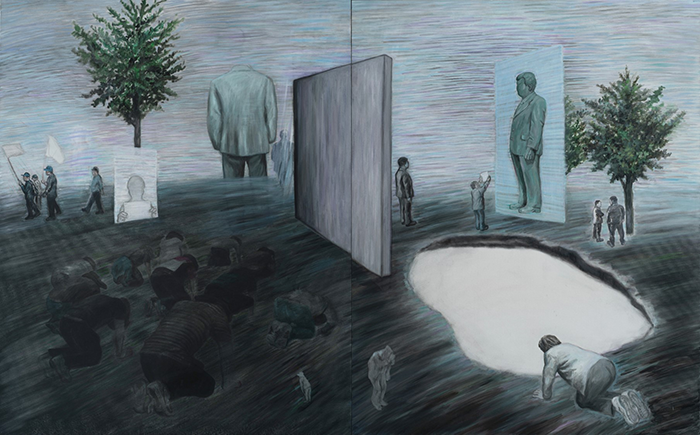
노원희, <얇은 땅 위에>, 2019, 캔버스에 아크릴릭, 유채, 162×130.5cm (2)
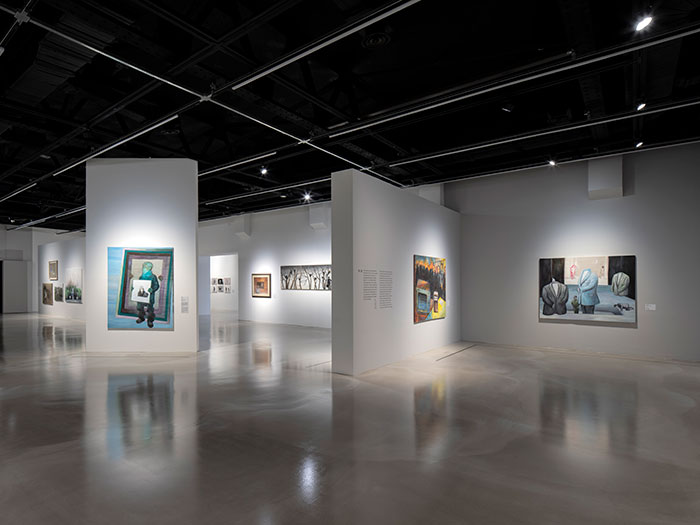
작품 설치 전경
노원희의 회화에는 한국 사회의 정치적 현실에 대한 발언과 표현의 의지가 담겨 있다. 그의 그림에 등장하는 하얀색 사각형, 쓰고 지워진 글자들은 현실의 조각을 유추하게 하면서 보는 이로 하여금 사회구성원들이 체감한 공통의 경험을 떠올리게 한다. 한국 사회 구조의 심각한 모순은 2009년 용산 참사, 2009년부터 진행된 쌍용자동차 해고자 복직 요구와 농성, 2014년 세월호 사건, 2016년 국정농단 등과 같은 사건이 벌어질 때 포착된다. 그리고 이후에 개인과 집단에 외상을 남긴다. 재난이나 사고가 일어난 뒤 사람들의 정서는 다른 국면으로 전환되거나 다른 시공간에서 새로운 의지로 출현되기도 한다. 작가는 당시의 현실을 연극 무대와 초현실적 공간으로 조성하고 사건 후 책임회피를 위해 은밀한 대화를 나누는 관계자들의 형상을 그리거나, 도시에서 목격했던 시위 현장의 가라앉은 정동을 표현했다. 또한 사건 당사자들이 시위하는 모습을 그리기도 했는데, 그 존재들은 하나의 사건으로부터 또 다른 사회적 사건에 다가가 연대하고 함께 힘을 모았던 사람들이다. 얇은 색 막이나 붓질로 만든 터치의 두께 차이, 세밀하게 묘사된 형상, 쓰인 메시지들, 실루엣으로만 그려진 사람들의 동작 등이 평면 공간의 깊이를 형성해 내면서 개인과 공동체가 겪은 실존의 무게를 전해준다.
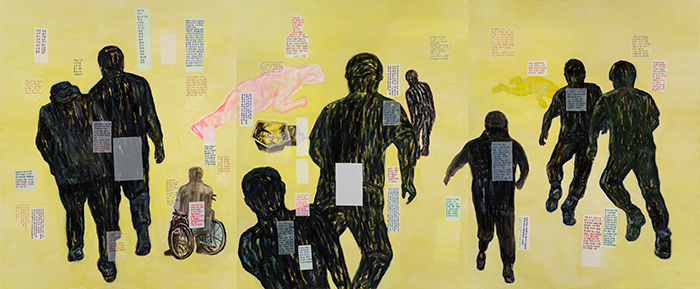
노원희, <사복으로 갈아입히고>, 2023, 캔버스에 아크릴릭, 천 콜라주, 162×130cm (3)
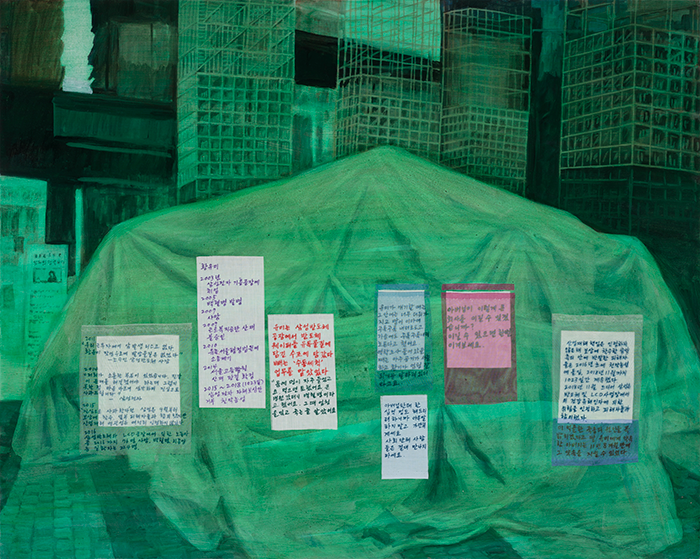
노원희, <큰 회사>, 2023, 캔버스에 아크릴릭, 천 콜라주, 80×100cm
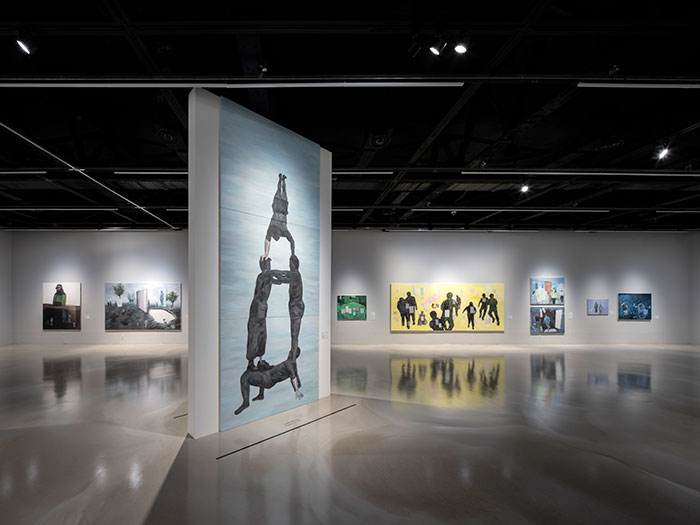
작품 설치 전경
산업재해는 오늘날 한국 자본주의 경제 시스템에서 발생하는 노동착취 문제를 극명하게 보여준다. 이에 대한 연작은 신문, 방송과 같은 대중매체를 통해 접하는 현실이자, 산업재해를 겪거나 희생당한 노동자, 학생 등 시민인 동시에 개인이기도 한 이들에 대한 생생한 현실 기록에 가깝다. 자본주의 사회에서 개인은 먹고 사는 것에서부터 아침저녁 시간까지 자본주의 노동 시스템 안에서 체화되고 소비 경제체제에 포획된 몸이지만, 그러한 사실은 일상적 차원에서는 가시화되지 않는다. 산재는 자본주의 체제의 구조적 시스템이 선사하는 환상의 이면을 개인의 몸에 선명하게 새기며, 신체장애나 수많은 죽음으로 그 모순을 가시화한다. 이 연작에서는 산재 이후 개인의 삶에 남겨진 고통과 남은 자들의 증언을 통해 하청과 외주화라는 왜곡된 노동시장의 모습을 확인하게 한다. 〈사복으로 갈아입히고〉(2023)에서는 최근의 여러 산재 사고들, 즉 구의역 스크린도어 수리 사고, 태안화력발전소 사고, SPC 계열사 제빵공장 소스 배합기 사고, 안성 물류창고 붕괴 사고와 같이 구멍 난 사회 시스템으로 인해 희생된 형상들이 그림자처럼 움직인다. 〈사복으로 갈아입히고〉, 〈큰 회사〉(2023)에는 작가의 회화에 줄곧 등장해 말을 하는 하얀 사각형을 대신하여 캔버스 표면에 얇은 천이 포스트잇처럼 부착된다. 하얀 사각형이 공간을 분할하고 침묵의 말하기를 시도했다면, 표면에 부착된 사각의 천 위에는 산업재해 피해자의 증언을 받아씀으로써 발화, 즉 ‘말하기의 기능’을 강화한다. 〈탑〉(2023)은 해병대 인터넷 카페에서의 월남전 당시 찍은 사진을 원용한 작품이다. 국가는 베트남 전쟁을 통해 근대화와 자본이 팽창하는 기회로 삼았다. 국가의 개입 하에 자본을 확장하려는 욕망은 성장 중심의 자본주의 모습을 드러낸다. 작가는 참전 용사들의 건장한 신체와 산업재해 피해자의 취약한 신체를 겹쳐 그리며, 의수와 의족을 끼고 아슬아슬한 포즈로 서로를 지탱하고 있는 몸의 탑을 통해 한국 산업노동의 모순을 재현한다.
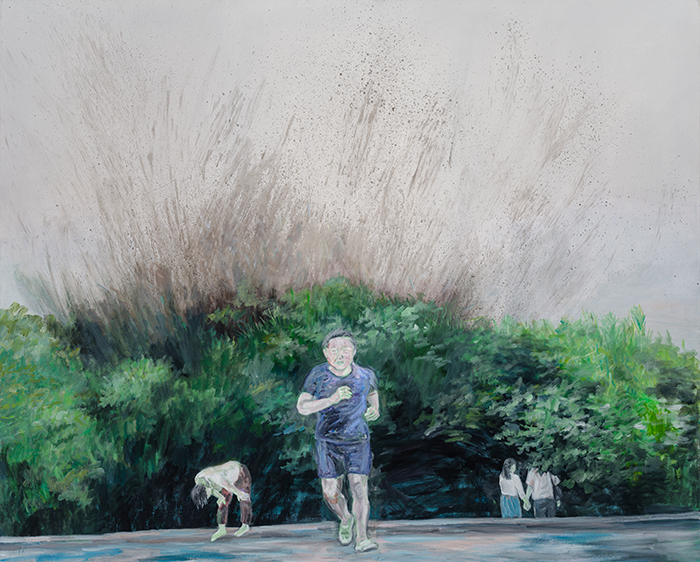
노원희, <아침운동 2023>, 2023, 캔버스에 아크릴릭, 130×162cm
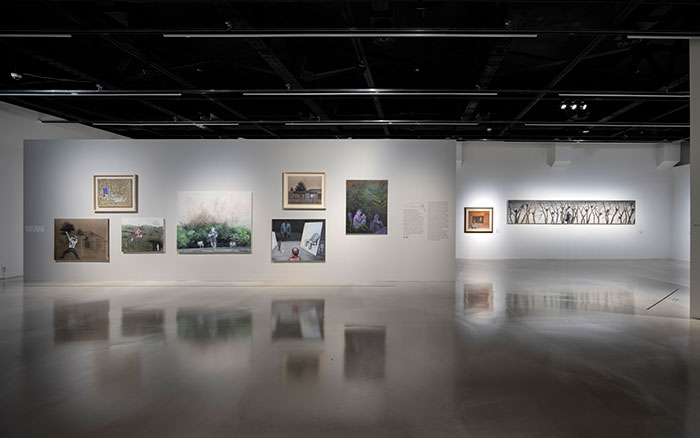
작품 설치 전경
1997년 IMF 외환위기는 한국의 ‘신자유주의적 전환’을 야기했던 계기로, 새로운 금융축적의 논리가 사회를 지배하고 삶의 영역을 잠식해 나가던 시간대의 시작이다. 작가는 자기 계발 열풍이나 치열하게 경쟁하며 사는 삶의 표본을 회의하고, 실업, 백수 등을 주제로 한 〈낮잠 좀 자지 마세요〉(2005), 〈너나 열심히 하세요〉(2015) 등의 작품으로 IMF 이후 감지된 집단 정서를 담아냈다. 1999년 〈아침운동〉은 ‘웰빙’ 열풍이 불던 시기, 건강한 몸을 가꾸는 데 열심인 세태를 다루고 있으며, 2023년 〈아침운동 2023〉은 미세먼지로 가득한 오늘날의 생활환경을 드러내는 것으로서 24년 전 〈아침운동〉의 변주라 할 수 있다. 한편, 현시대의 청년은 공동체의 미래를 상상할 수 있게 하는 잠재성으로 평가되고 있지만, 실제 그들의 삶은 극도의 생존경쟁이라는 현실에 노출되어 있다. 청년의 고단한 삶은 〈라면 먹는 사람들〉(2002)에서 스산한 징후로 기시감을 느끼게 하고, 〈사발면이 든 배낭〉(2016)에서 구의역 스크린도어 수리 사고로 사망한 19살 김 씨의 형상으로, 또는 〈청년의 봄〉(2003)을 통해 누군가 바랐던 꿈과 잠으로 이어진다.
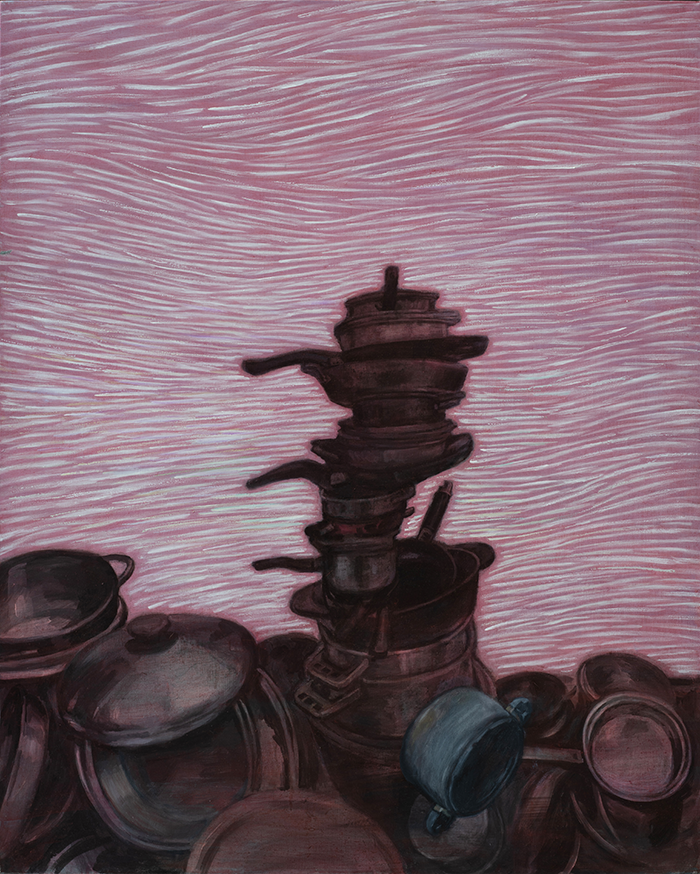
노원희, <오래된 살림살이 2>, 2019, 캔버스에 아크릴릭, 100×80.5cm
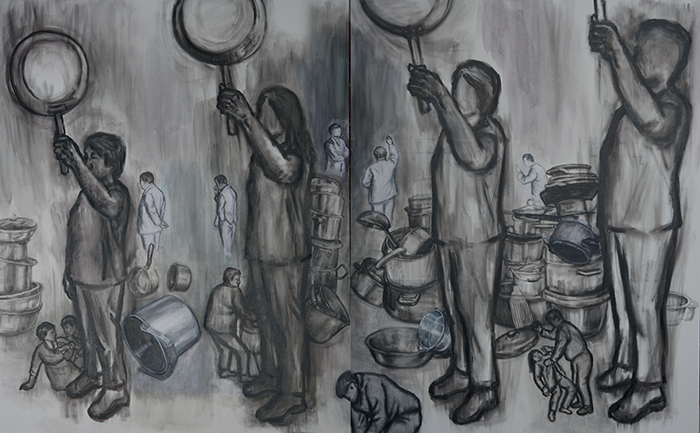
노원희, <무기를 들고>, 2018, 캔버스에 유채, 162×130.5cm (2)
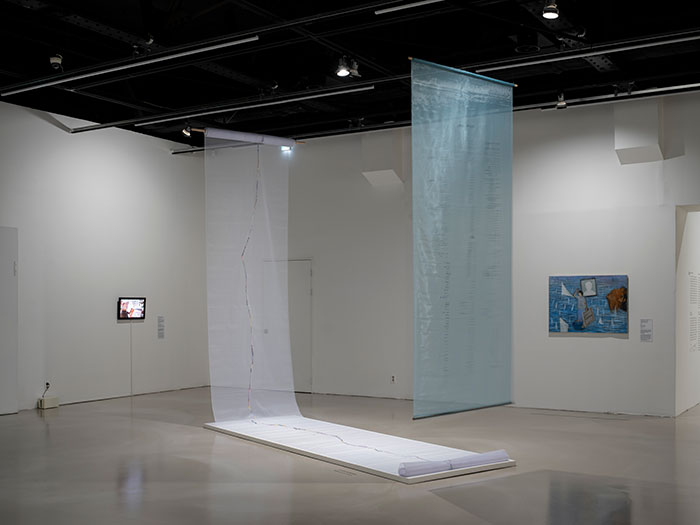
노원희,<즐거운 바느질 시간>, 2020(2023년 설치), 천에 실, 실크스크린, 디지털 사진 재가공, 가변 크기
《그림과 말 2020》(학고재, 2020) 연계 프로그램의 공동 제작 작업을 재가공 및 설치
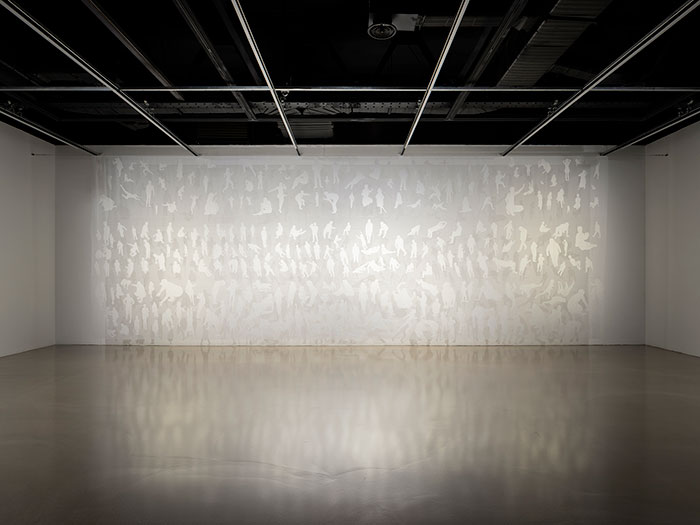
노원희,<몸 53>, 2023, 천에 젯소, 337×955cm
제작 참여: 윤결, 정덕현
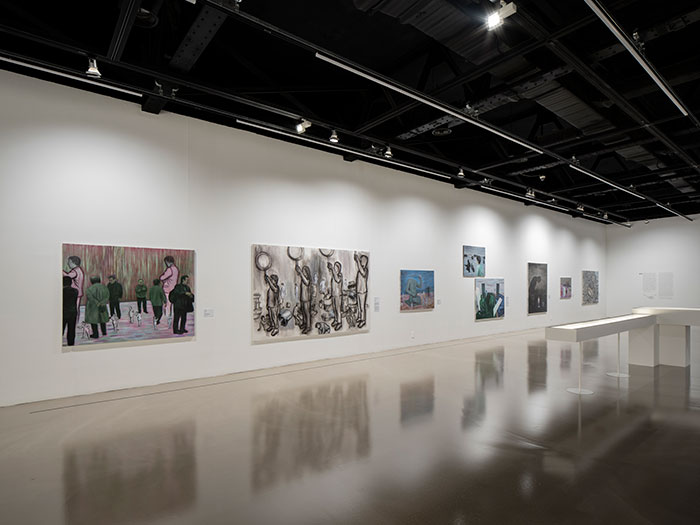
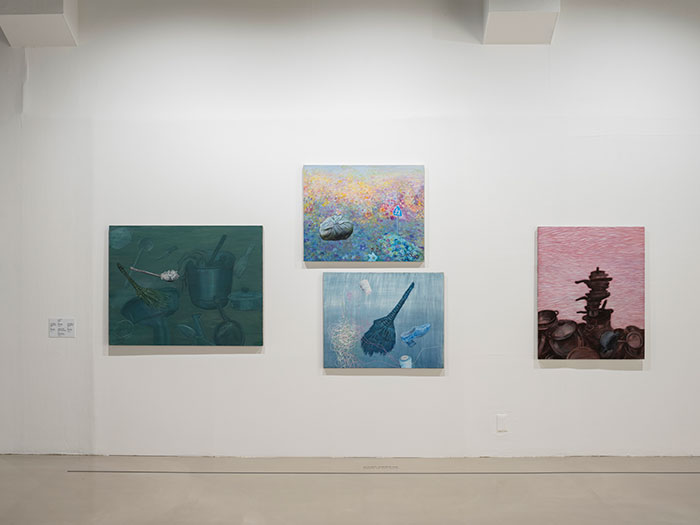
작품 설치 전경
한국 사회에서 일어난 젠더 문제들이 가시화되고 일련의 사건들이 소용돌이 칠 때, 노원희는 여성으로서 자신을 일깨우고 여성 서사에 관심을 기울이기 시작했다. 일상과 사적 공간에 침투하는 폭력과 억압, 그리고 혐오의 정치를 목격하며 작가는 사회 현실과 미래 세대에 대한 걱정과 불안을 내비친다. 여성 개인의 서사를 담고 있는 노원희의 작품들은 남성 중심적 사회에서 당연시되는 관습에 질문을 던진다. 작가가 미디어에서 접한 정보를 바탕으로 그린 이주 여성 이야기, 베트남 전쟁 참전 후 고엽제 피해를 입은 남편의 가정폭력으로 얼룩진 가정사는 여성 인권의 문제가 정치사회적 문제와 밀접한 연관성이 있음을 확인하게 한다. 한편, 사회 재생산에 있어 실질적 역할을 하는 여성의 노동은 쉽게 비가시화되거나 사적 차원으로 축소되곤 한다. 2001년 〈오래된 살림살이〉에서는 살림살이에 위태하게 발을 딛고 있는 모습으로 가사노동에 대한 작가의 부담감을 내비쳤다. 2018년 〈무기를 들고〉는 “가사노동에 대한 임금 캠페인”(Wages for Housework Campaign)이라는 1970년대 미국 여성운동의 캠페인을 떠올리며 그린 것이다. 살림살이를 무기처럼 들고 항의하는 인물들은 당시 한국의 “미투 운동”(Me Too Movement)을 지지하는 여성들의 강한 의지를 보여준다.
아카이브
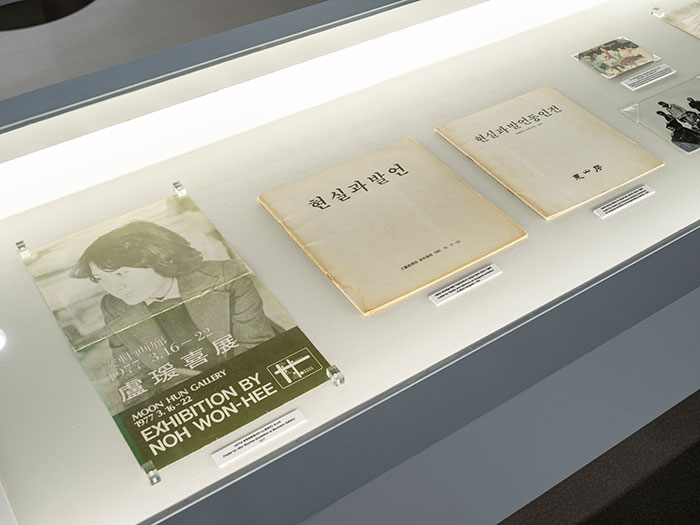
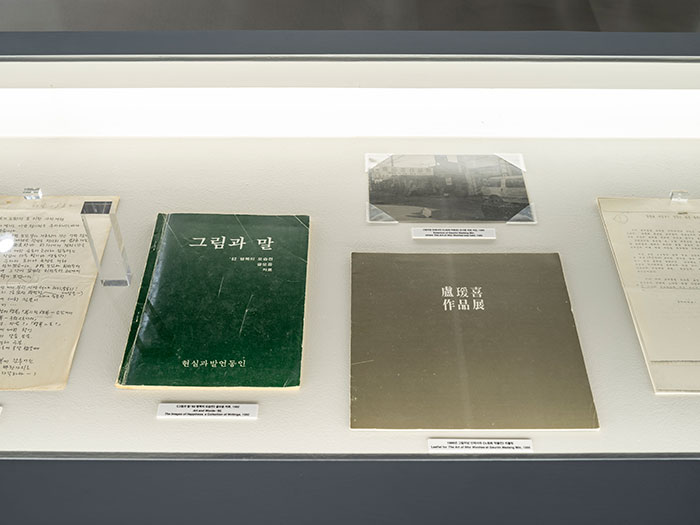
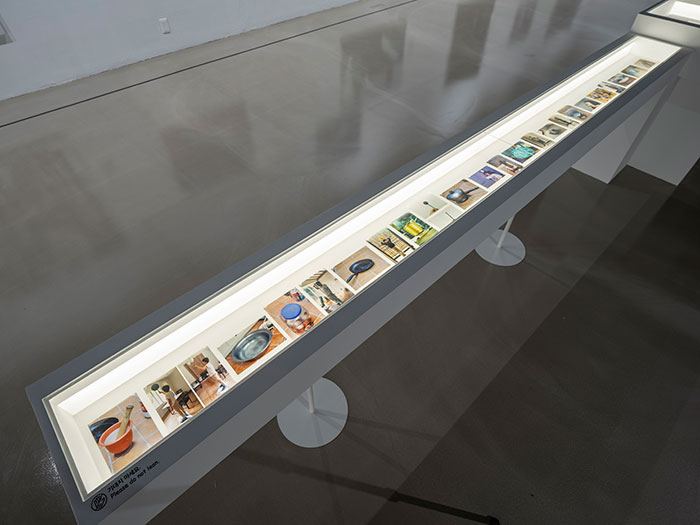
아카이브 설치 전경
아카이브 섹션은 교육자이자 ‘현실과 발언’ 동인이었던 노원희의 활동과 미술에 대한 생각을 자료를 통해 보여준다. 1977년 문헌화랑에서의 첫 개인전, 문화예술진흥원 미술회관에서의 현실과 발언 창립전, 동산방 화랑에서의 창립전 도록과 구성원들의 사진, 제3세계 미술과 행복을 주제로 한 현실과 발언의 워크숍 문서, 전두환 정권에 대한 저항 운동과 투쟁이 치열하게 전개되었던 시기인 1986년 그림마당 민에서의 개인전 리플릿과 사진, 동의대 교수 재임 당시 1986년 시국선언에 참여한 동료 교수 해직 철회와 학원 민주화를 요구하는 입장문, ‘5.3 동의대 사건’으로 학생들이 선고받은 형벌과 교수 해직의 부당성에 대해 이야기한 신문 칼럼 등을 접할 수 있다. 또한 민중과의 소통에 대한 글, 정치적 미술을 지향하는 행동주의 공공미술에 대한 논고에서는 작가의 미술에 대한 지향성과 그림을 이루는 생각의 토대를 살필 수 있다.
한편, 노원희의 그림에서는 다양한 인간의 형상, 포즈를 발견할 수 있다. 형상을 그리기 위해 작가가 가족과 본인의 몸동작을 찍은 일련의 사진들은 회화의 재현 과정을 짐작할 수 있는 자료이다. 이 사진 자료에서는 작업의 즐거움과 생활의 기쁨을 포착할 수 있다.
신문 연재 소설 『바리데기』 삽화
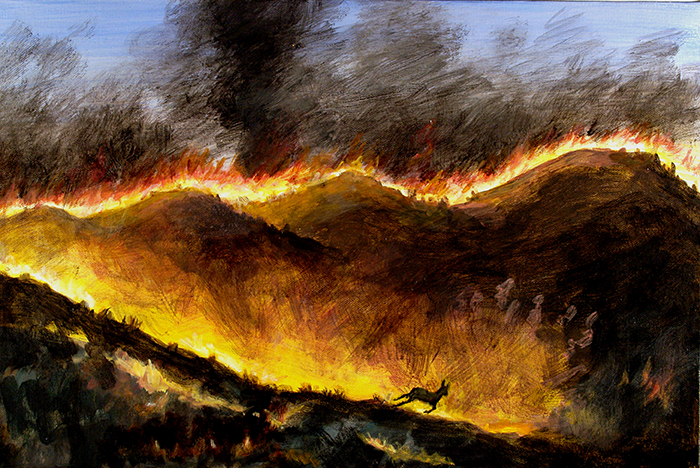
노원희, <37회: 불지옥 산속을 기듯이 헤치고>, 2007, 캔버스에 아크릴릭, 크레파스, 30×45cm
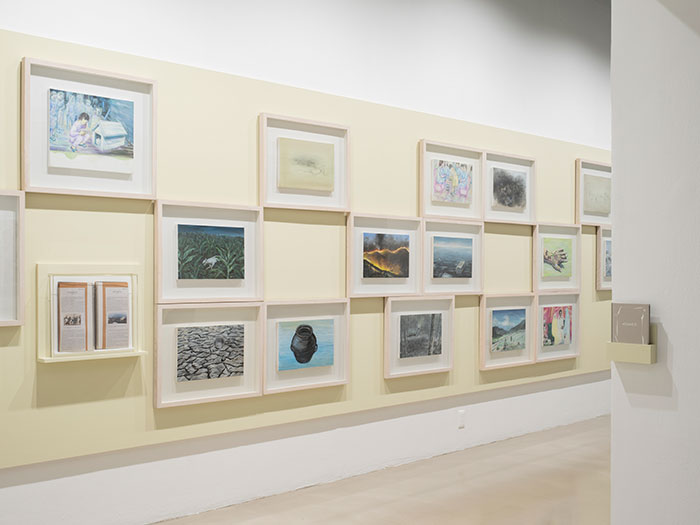
『바리데기』 삽화 설치 전경
이번 전시에서는 소설 『바리데기』 연재 당시의 신문 스크랩북과 삽화 회화를 선보인다. 노원희는 『한겨레』 신문에 연재되었던 황석영의 소설 『바리데기』(2007년 1월 3일-6월 20일) 삽화를 그렸다. 이 삽화는 소설의 원고를 1회분씩 받아 그림을 그려야 하는 삽화 작업의 특성상 연재 기간 동안 매일 그려졌다. 노원희의 삽화는 황석영의 소설에 호응하며 121회를 끝으로 막을 내린다. 소설 『바리데기』의 묘미인 현실과 환상을 넘나드는 판타지적 묘사와 함께 노원희의 삽화는 이국적이고 초현실적인 장면을 담아낸다. 105회 삽화는 『바리데기』 소설의 주인공인 바리의 꿈속에서 실종된 남편 알리가 닭장 같은 철망 안에 갇혀 웅크리고 있는 장면을 그렸는데, 이 인물의 형상은 〈몸〉 연작의 출발점이 된다. 『바리데기』 삽화 연작은 작가의 기존 회화와는 다른 경향의 작품이지만, 주인공 바리처럼 영겁의 삶을 담담하고 묵묵하게 살아가는 인간의 서사는 노원희가 그동안 주목했던 개인의 삶의 형상을 비춰 볼 수 있게 한다.
▣ 전시장 전경
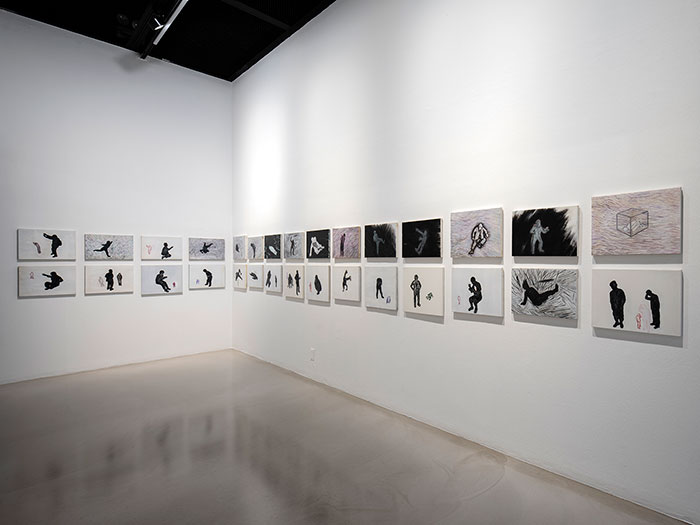
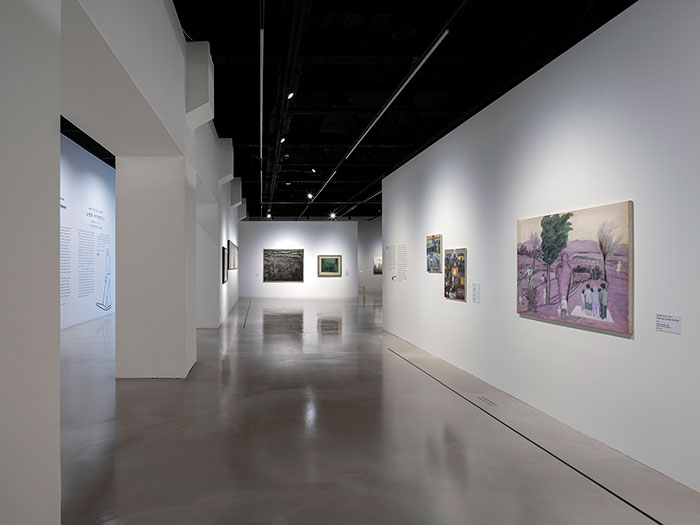
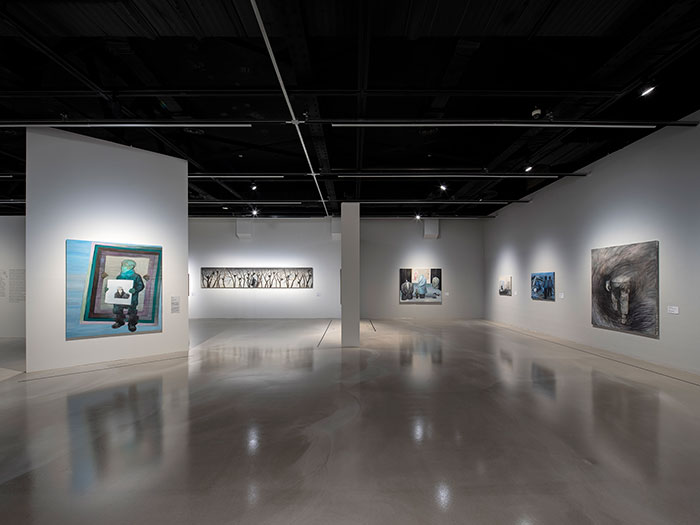
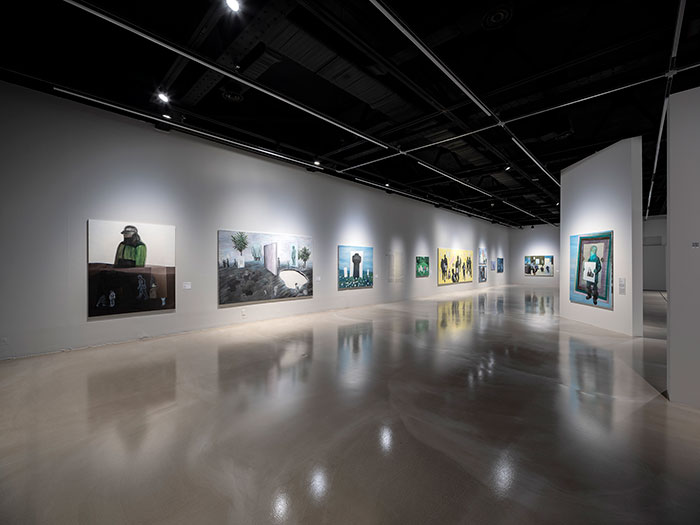
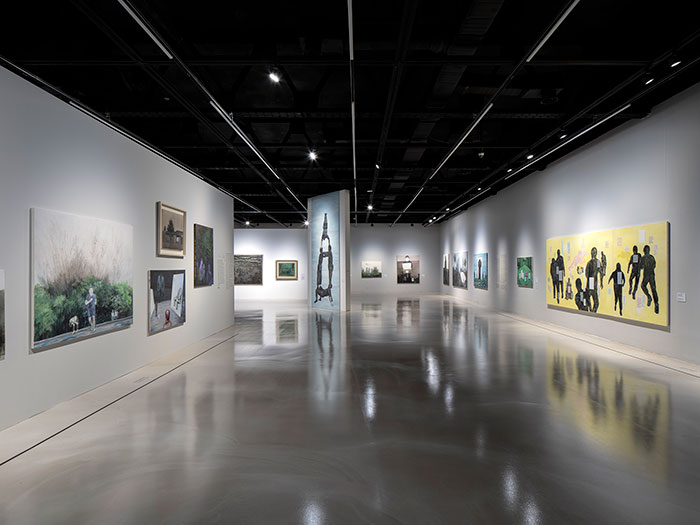
제1전시실 전경
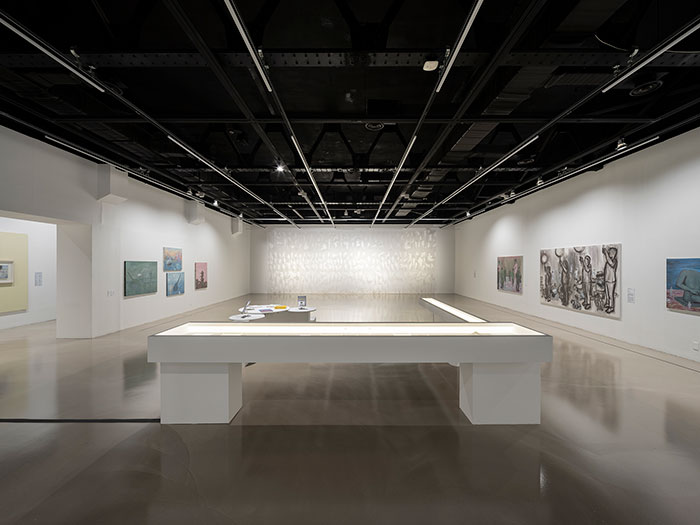
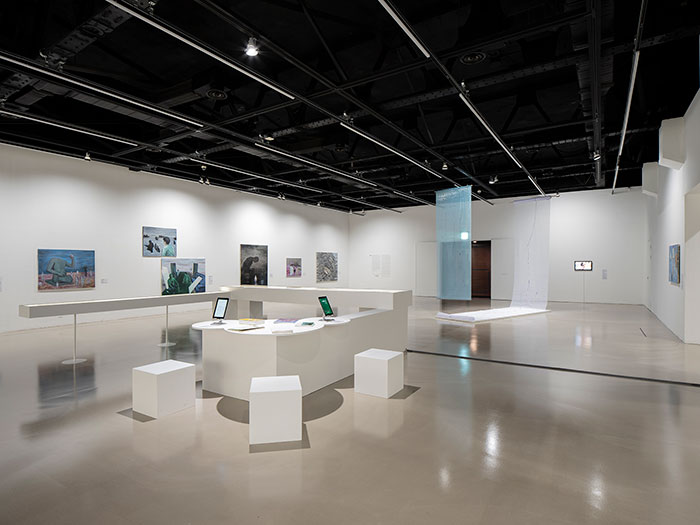
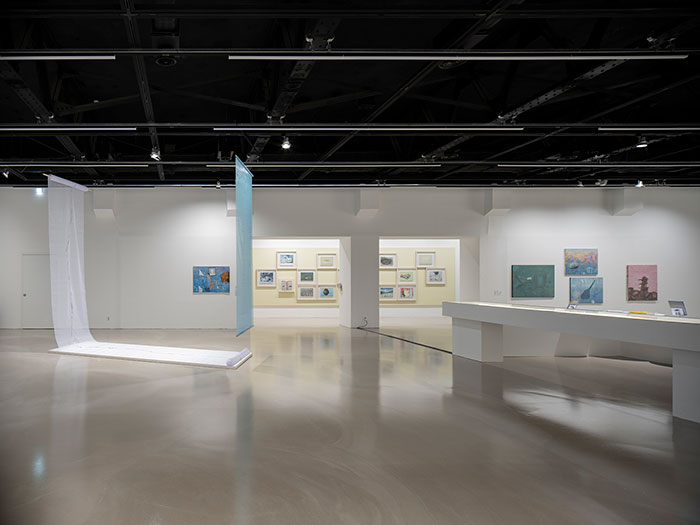
제2전시실 전경
▣ 작가소개
노원희는 1948년 경북 대구 출생으로 서울대학교 미술대학 회화과에서 학사와 석사 학위를 받았다. 1977년 문헌화랑에서 첫 개인전을 열었고, 1980년 ‘현실과 발언’의 창립동인으로 1990년 해체될 때까지 동인전에 참여했다. 1982년부터 2013년까지 부산 동의대학교 교수로 재직하며 교육자이자 작가로 활동했다. 노원희의 회화는 시대의 변천에 따른 역사 인식, 현실 인식을 토대로 개인과 집단이 만들어 낸 사회와 정치, 문화의 정황을 심리적 풍경으로 포착했다. 개인전으로 《얇은 땅 위에》(2019, 학고재), 《담담한 기록: 인간사, 세상살이, 그리고 사건》(2017, 아트 스페이스 풀), 《남아있는 풍경: 노원희 1991년 이후》(2006, 숙명여자대학교 문신미술관), 1986년 그림마당 민에서의 개인전 등 17회의 개인전을 열었다. 단체전으로는 《미니멀리즘-맥시멀리즘-메커니즈즈즘 1막–4막》 (2022–2023, 아트선재센터, 오르후스미술관), 《2020 부산비엔날레: 열 장의 이야기와 다섯 편의 시》(2020, 부산현대미술관), 《그림과 말 2020》(2020, 학고재), 《세상에 눈뜨다: 아시아 미술과 사회 1960s–1990s》(2019, 국립현대미술관 과천), 《베트남에서 베를린까지》(2018, 국립아시아문화전당 문화창조원), 《2012 부산비엔날레 – 배움의 정원》(2012, 부산시립미술관), 《민중의 고동: 한국미술의 리얼리즘 1945–2005》(2007–2008, 후추시 미술관, 오타니 기념미술관, 미야코노조시립미술관), 《’99 여성미술제 – 팥쥐들의 행진》(1999, 예술의전당 한가람미술관), 《광주비엔날레 특별전 – 광주 5월 정신》(1995, 광주시립미술관), 《민중미술 15년: 1980–1994》(1994, 국립현대미술관) 등에 참여했다.
▣ 전시 연계 프로그램
| 프로그램명 | 일정/장소 | 진행자 |
|---|---|---|
| <작품 해설 쓰기> 워크숍 | 8.31(목), 예술가의 집 2층 라운지 | 어딘(김현아 작가) |
| <거기서 읽고 계셨군요> 읽기모임 | 9.16(토), 아르코미술관 및 예술가의 집 2층 라운지 | 노해나(아르코미술관 큐레이터), 김치현(책방 풀무질 대표) |
| 토크 프로그램(가제) | 10월 예정 | 미정 |
전시 연계 프로그램에 대한 상세 정보는 아래 페이지에서 얻으실 수 있습니다.
자료담당자[기준일(2023.8.10.)] : 미술관운영부 노해나 02-760-4607
게시기간 : 23.8.10. ~
2023 ARKO Art Center Invitational Exhibition Nho Wonhee: You were there

- Artist : Nho Wonhee
- Period : August 11 – Nomeber 19, 2023
- Opening Hours : Tue – Sat, 11am – 7pm(Closed on Mondays and Korean Thanksgiving Day)
- Venue : ARKO Art Center, Gallery 1, 2
- Admission : Free
- Host : Arts Council Korea
2023 ARKO Art Center Invitational Exhibition—which seeks to encourage mid-career and earlier generations of artists to produce new works, support their artistic pursuits, and highlight their oeuvres—presents a solo exhibition by Nho Wonhee (b. 1948). Nho embarked on her creative journey in 1977 when she held her first solo show. She was also a founding member of Reality and Utterance, a small art group movement that began in 1980.
The group’s inaugural exhibition, Reality and Utterance, was scheduled to be held at the Misul hoegwan (now ARKO Art Center) in 1980; however, it was canceled because the show was considered overly political in the conservative social atmosphere of the time. ARKO Art Center, which will soon celebrate its 50th anniversary, has invited Nho to put on a solo exhibition to reflect on her history as an artist from a contemporary perspective and carefully trace her outlook on individuals and society through her many years of artistic practice.
Nho Wonhee: You were there consists of approximately 130 artworks and archive materials that exemplify her career as an artist, including her paintings from the 1980s, new paintings, large-scale fabric paintings, participatory artworks, and illustrations from a novel serialized in a newspaper. Her work is often associated with the terms, Minjung Art (People's Art), Busan Figurative Art, and Critical Realism. However, when examining her creative journey, one discovers aspects that cannot be completely explained with reference to any specific movement or the existing vocabulary of art history. When following her speaking with wordless painting, her empathy and compassion for human beings and the world, and her attitude towards reality and history, one encounters the psychological figuration of the era, which the artist senses and recognizes through her brushstrokes. Therefore, this exhibition serves as an opportunity to examine Nho’s artistic endeavors to document the personal and social aspects of human affairs that she has witnessed and undergone as an artist and a human being, which she expresses through the visual language of painting.
Nho’s work testifies to the social circumstances and psychological hardships that individuals and communities have been subjected to. Beginning in the 1980s, which was marked by the tension between intensifying political repression and the growth of the pro-democracy movement, Nho dedicated herself to recording the zeitgeist of the time. After the front lines of the social movement collapsed, politico-social disorder and structural violence in the capitalist society cast shadows over everyday life that appeared calm. Society subsequently transitioned into an era where inequality, contradiction, and alienation penetrated deep into personal life. Facing reality, Nho strived to contemplate the systemic paradox between society and human conditions. Her artistic practice is about understanding reality in detail and communicating it through the language of painting. It is also related to her determination to document the real world in a composed manner with an awareness of history, which is her way, as a critical realist, of examining the true shape of reality detached from the conventional veneer of truth. For those who can only vaguely recognize the structures of the cleverly obscured repression and violence generated by the real-world micropolitics that surrounds them, Nho’s work provides a clear vision for seeing reality as it is, as it serves as a window onto the truth beyond reality.
This exhibition is structured to reveal her utterances and determination to address social issues at the intersection between the public and private sectors. Gallery 1 presents Nho’s new works that focus on industrial disasters caused by the structural problems of Korean capitalism and the resulting suffering of individuals. These works are an extension of her portrayals of workers and state power that she began in the 1980s. These stories of victims develop into narratives about young people, workers, and protesters whose dignity is repeatedly threatened in the current era. Gallery 2 attends to the artist’s interest in female narratives, which she has had first-hand experience of. These narratives deal with the violence and repression that permeate everyday life and private spaces, as well as the artist’s meditation on the shared story of humankind. The social oppression and alienation that infiltrate one’s life and places like the home and the kitchen confront the individual and make them aware that personal spaces are social spaces and sites of political resistance.
The artist aims to transcend simple representations to visualize underlying personal and social circumstances. In this way, the exhibition allows audiences to discover images of solidarity painted by social others and beings through the portrayals of labor and body concealed behind public and private sectors. The exhibition title, “You were there”1) speaks to alienated members of society. This phrase, which directly addresses the listener recognizes the person’s place and has the potential to develop into a dialogue. It prompts a conversation and foreshadows a story that will follow. Social changes begin when one stands in solidarity with those suffering and acknowledges their place in society by calling their names. This is the power of “images and words” that Nho strives for.
1) The phrase "You were there" is from Nho's artist statement. She quotes the line "You're still there, huh?" from the film The Last Waltz (1978), uttered by a band member to someone in the audience after the band's final performance finishes and the curtain closes. The artist rewrote this line as "You're not there," reflecting that Reality and Utterance is now part of the history of a bygone era—that is, it is part of the historical record. It also indicates that the meaning of their manifesto has changed. The exhibition title, "You were there," reflects one's personal place called upon in Nho's painting and the time when human life continues, representing the arrival of the next society that one is dreaming of.
▣ About the Sections

Nho Wonhee, Time That Leaves the Park, 2016, acrylic and oil on canvas, 91×117cm

Nho Wonhee, A Main Street, 1980, oil on canvas, 130.3×162.1cm. MMCA Collection


Installation veiw of Artworks
In the 1980s, social movements in Korea developed into a transformative national movement known as the minjung movement, which sought to contemplate human life comprehensively. Vigorous popular resistance succeeded in restoring the political freedom that had been taken away during the years of military dictatorship. However, people’s interest in the macro narrative—the force behind the national cultural movement of the 1980s—soon dissipated. By the 1990s, the front lines of artistic and cultural resistance had collapsed, and post-modernism was introduced from the West, giving birth to the culture of a new generation that was characterized as trendy. Indeed, this new lifestyle did not carry on the critical and ethical prospects of the cultural movement of the 1980s. In this drastically altered world, Minjung artists wandered in agony, attempting to overcome their inner turmoil. They strived to draw attention to unstable socio-cultural conditions and forge a new path.
Nho, meanwhile, was more concerned with expressing the social contradictions that ruled the lives of individuals than with presenting new visions or incorporating the recently developed vocabulary of media art. As an artist who was a witness to turbulent times, she recognized ongoing changes and incorporated them into her canvases. Her paintings reveal the conditions of severance, transition, and progress, which characterize the end of an era, and reorganize its remainders into a new form. The heavy atmosphere and sense of absence in her work come from looking back on the past and facing the current state of society to unveil the external wound that reality carries.

Nho Wonhee, On Thin Land, 2019, acrylic and oil on canvas, 162×130.5cm (2)

Installation veiw of Artworks
Nho’s paintings reveal a determination to convey the political circumstances of Korean society. White squares and the marks of erased writing in her paintings appear as fragments of the real world, evoking experiences shared by community members. The contradictions of Korean society become more transparent in moments of tragedy, such as the ongoing Ssangyong Motors strike for the reinstatement of dismissed workers that began in 2009, the Sinking of the MV Sewol in 2014, and the South Korean political scandal of 2016. These incidents have cut deep into the lives of individuals and communities. After devastating events, people’s perceptions often shift or transform, resulting in a new kind of willpower manifested in different times and spaces. Nho created a stage performance with surreal atmospheres that evokes past moments in history by portraying officials discussing matters privately to deflect blame, as well as demonstrators looking somber in the city center. Nho’s paintings also feature protests held by the direct victims of these incidents. These people survived past disasters and gradually formed bonds of solidarity with others affected by social tragedies. Layers painted in pale colors, brushstrokes with different thicknesses, painstakingly depicted figures, written messages, and people’s silhouetted gestures add depth to the two-dimensional surface of her paintings, evoking the weight of existence felt by the communities and individuals.

Nho Wonhee, Dressing Them in Civilian Clothes, 2023, acrylic on canvas, fabric collage, 162×130cm (3)

Nho Wonhee, Large Corporation, 2023, acrylic on canvas, fabric collage, 80×100cm

Installation veiw of Artworks
Industrial disasters are events that reveal underlying labor conditions and the disregard for human dignity under capitalism. Nho’s series of works on this topic relates the real stories of individuals told by mass media outlets—such as newspapers and news media shows—and closely documents the lives of these individuals who are also citizens, students, and workers who have been injured or deceased in industrial accidents. Contemporary citizens spend each day ensuring that their bodies conform to the demands of the capitalist labor system. However, these bodies caught in the economic system are barely visible in everyday life. Industrial disasters leave clear marks that lay behind the fantasy that the capitalist system provides; this discrepancy becomes conspicuous through countless reports of disablement and deaths. Through its engagement with the suffering bodies and testimonies of survivors, Nho’s series presents a clear image of the distorted labor market, which is characterized by subcontracting and outsourced labor. In Dressing Them in Civilian Clothes (2023), victims of recent industrial disasters—such as the Guui Station accident, the Taean Power Plant tragedy, the fatal sauce mixer accident at an SPC Group factory, and the construction site accident at an Anseong warehouse—appear to move as if they are shadows. In her previous works, Nho has employed white squares as spoken words. In Dressing Them in Civilian Clothes (2023) and Large Corporation (2023), however, Nho attaches thin fabric squares to the canvas like sticky notes. While the white squares divide space and represent a silent speech, the fabric squares that are attached on the surface, in contrast, are inscribed with the testimonies of industrial disaster victims, reinforcing their function of conveying a message, of speaking. Tower (2023) utilizes a photograph taken during the Vietnam War that was circulated among the South Korean Marine Corps internet community. The nation took advantage of the Vietnam War as a chance to further modernize the country and increase its financial assets. South Korea’s intention to build its wealth through government intervention reveals the cutthroat nature of capitalism. In the painting, Nho overlaps the solid bodies of war veterans with the feeble bodies of industrial disaster victims. The tower made of bodies with prosthetic arms and legs precariously sustaining each other, represents the conflicting reality of Korean industrial labor.

Nho Wonhee, Morning Workout 2023, 2023, acrylic on canvas, 130×162cm

Installation view of Artworks
The 1997 Asian financial crisis transitioned the nation into a new era of neorealism where financial accumulation dictated society and ate away at daily life. Nho expresses her skepticism of the life model that encourages self-improvement and ruthless competition after the Asian crisis through the paintings, Please Do Not Take a Nap (2005) and Mind Your Own Business (2015). These notes on society predate in Morning Workout (1999) where she depicts the social trend to build healthy bodies in pursuit of new concepts of “well-being.” In 2023, Nho also painted a variation of the 1999 painting, Morning Workout 2023 (2023), which reflected people’s living conditions surrounded by fine dust pollution. Even though today’s young generation is considered to have the potential to lead their communities to a better future, their lives are, in fact, subjected to an extreme trial of survival of the fittest. People Having Ramen (2002) is like a moment of déjà vu portraying young, fatigued people. These worn-out people reappear in Backpack Packed with Instant Ramen (2016), through the example of Mr. Kim, a nineteen-year-old man who died when he was crushed between the screen doors at Guui Station in 2016, and in Spring of Youth (2003), where people are finally given the opportunity to sleep and dream—something that they, and many others, had long yearned for.

Nho Wonhee, Old Household Goods 2, 2019, acrylic on canvas, 100×80.5cm

Nho Wonhee, Taking Up a Weapon, 2018, oil on canvas, 162×130.5cm (2)

Nho Wonhee, Time to Enjoy Sewing, 2020 (installation completed in 2023), thread on fabric, silkscreen, video comprised of photographic documentation, dimensions variable
Art and Words 2020 (Hakgojae, 2020), a collaborative piece for exhibition-related programs, reproduced and installed for the exhibition

Nho Wonhee, Body 53, 2023, gesso on fabric, 337×955cm
Assistant | Yoon Gyeol, Jeong Deokhyeon


Installation view of Artworks
At a time when a whirlwind of high-profile events had urged South Korean society to be more aware of gender issues, Nho had an awakening as a woman and became more inclined to female narratives. Witnessing the politics of violence and repression that permeate daily life and the private sphere, Nho reflected on her concerns and anxiety regarding social conditions and future generations. Her works dealing with women’s personal stories raise questions about the social and cultural norms of a male-centered society. Her works that are based on the stories she encounters in the media—such as stories about immigrant women, and those abused by their Vietnam War-veteran husbands who suffer from defoliant exposure—confirm that women’s rights are closely entwined with political and social issues. A female’s work—which is the sustaining force of social reproduction—tends to be invisible or easily dismissed as a taken-for-granted part of life. Old Household Goods (2001) features an individual balancing on top of household objects, a metaphor for the pressure the artist feels regarding housework. Taking up a Weapon (2018) was inspired by the “Wages for Housework campaign” led by American feminist movements in the 1970s. Nho’s work depicting women protesters holding household objects as if they were weapons is meant to represent the women supporting the Korean #MeToo Movement at the time.
Archive



Installation view of Archive
The archive section presents documents representing the career and thoughts of Nho Wonhee, who is an artist, educator, and former member of the group Reality and Utterance. This section features catalogs for Nho’s first solo exhibition at Munheon Gallery in 1977 and the inaugural exhibitions of Reality and Utterance at Misul hoegwan and DongSanBang Gallery, along with photographs of the Reality and Utterance members. Also on display is a document of the Reality and Utterance workshop on the art of third-world countries and happiness; a leaflet and photographs from her solo exhibition held at Geurim Madang Min in 1986 amidst the ongoing fierce popular resistance against President Chun Doo-hwan; a statement demanding the reversal of the dismissal of her fellow professor who participated in a collective declaration on the then current government, as well as the democratization of educational institutions; and a newspaper article on the punishment of students who participated in the May 3 Dong-Eui University Incident and the dismissal of professors who supported them. Furthermore, Nho’s writings about communicating with the public and her political arguments about activist art in public enable audiences to better understand her aspirations as an artist and the foundational ideas of her practice.
In Nho’s paintings, there are a plethora of human bodies of various shapes making a variety of poses. She took photographs of her family members and herself to study the human body. Some of these photographs are featured in this section, providing a glimpse into the artist’s painting process. These photographs reveal the joy of artmaking and daily living.
Illustrations for Princess Bari, a novel serialized in the newspaper

Nho Wonhee, Episode 37: Crawling through Burning Hell on the Mountain, 2007, acrylic and crayon on canvas, 30×45cm

Installation view of Illustrations for Princess Bari
This exhibition features a scrapbook of newspaper cut-outs and original illustrations by Nho Wonhee for the novel, Princess Bari. Written by Hwang Sok-yong, this piece was serialized in the newspaper, Hankyoreh, from January 3 to June 20, 2007. Nho drew an illustration daily for the series while it was being written, and completed the final 121st painting to correspond with the final installment in the story. Her illustrations that accompanied Hwang’s distinctive descriptions of crossing between reality and fantasy present unusual and surreal sights. Nho’s painting for the 105th installment portrays Ali, Bari’s husband, who is lost in Bari’s dream, curled up inside a crate resembling a chicken coop. This character’s pose became the starting point for another series titled Body. Nho’s paintings for Princess Bari are technically distinctive from her usual works, but her thematic interest in individual lives persists in the narrative of Bari, living her eternal life solemnly and diligently.
▣ Exhibition view





Installation view of Gallery 1



Installation view of Gallery 2
▣ About the Artist
Nho Wonhee was born in Daegu, Gyeonsangbuk-do in 1948 and earned her bachelor’s and master’s degree in painting at the College of Fine Art, Seoul National University. She held her first solo exhibition at Munheon Gallery in 1977. As a founding member of Reality and Utterance, she participated in various group exhibitions until the group disbanded in 1990. From 1982 to 2013, Nho remained active as an artist while also serving as an educator, holding a professorship at Dong-Eui University in Busan. Nho’s painting captures the psychological landscape of how society, politics, and culture are shaped through the individual’s and communities’ perception of history and reality that shifts over time. She has held seventeen solo exhibitions, including On Thin Land (Hakgojae, 2019), Documentary Persistence: Human Affairs, Ways of Living, and Crisis (Art Space Pool, 2017), Remaining Scenery: Nho Wonhee, After 1991 (Moonshin Museum of Art at Sookmyung Women’s University, 2006), and an exhibition at Geurim Madang Min in 1986. Her group exhibitions include Minimalism-Maximalism-Mechanissmmm Act 1–Act 4 (Art Sonje Center, ARoS Aarhus Art Museum, 2022–2023), 2020 Busan Biennale: Words at an Exhibition – an exhibition in ten chapters and five poems (Museum of Contemporary Art,Busan, 2020), Art and Words 2020 (Hakgojae, 2020), Awakening: Art in Society in Asia, 1960s–1990s (National Museum of Modern and Contemporary Art, Korea, Gwacheon, 2019), From Vietnam to Berlin (Asia Culture Center Creation, 2018), Art Toward Society: Realism in Korean Art 1945–2005 (Fuchu Art Museum, Otani Memorial Art Museum, Miyakonojo City Museum of Art, 2007–2008), Women’s Art Festival 99: Patjis on Parade (Seoul Arts Center, 1999), Gwangju Biennale Special Exhibition – The Spirit of Gwangju Resistance in May (Gwangju Museum of Art, 1995), and The 15 Years of Korean Minjoong Art: 1980–1994 (National Museum of Modern and Contemporary Art, Korea, 1994).
자료담당자[기준일(2023.8.10.)] : 미술관운영부 노해나 02-760-4607
게시기간 : 23.8.10. ~
